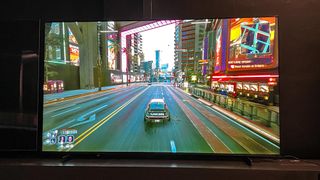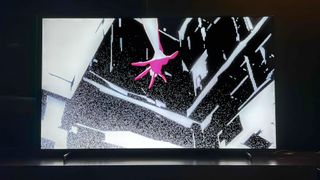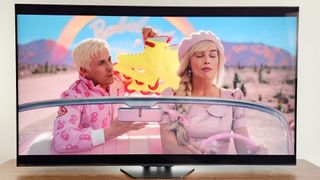The 2024 TV race is off to a strong start with TCL and Hisense launching a major battle in the ring against rivals LG and Samsung. Both manufacturers tout the potential of ever-improving Mini-LED panels, as well as the benefits of improved AI processing.
One of the main contenders at the forefront of this race is the TCL QM8 Mini-LED TV (2024), which sits at the top of the TCL 2024 TV lineup. Although it may not be As powerful (or as big) as the QM89 Mini-LED TV, the QM8 is an attractive new QLED built on an entirely new foundation on which TCL invents QD-Mini-LEDs.
Then there’s the Hisense U8N mini-LED TV which sits just below its U9N counterpart in the Hisense 2024 TV lineup. Using the Hi-View Engine Pro as its main AI processor, the U8N is an offering stunning TV that starts at the incredibly low price of $1,099 for its 55-inch model, potentially making it one of the best 55-inch TVs on this year’s market.
The two TVs are seemingly neck and neck in terms of quality. They use Full Array local dimming and mini-LEDs on an LCD panel for superior picture quality. Like most manufacturers, TCL and Hisense are also touting the high-flying potential of their AI chips, which will give their respective displays some serious firepower in everything from scaling to motion processing.
Which mini-LED TV is superior? We’ve put them through their paces, looking at everything from price to specs and performance, to give a full breakdown of what consumers can expect from both models. Let’s find out which Mini-LED TV is not only the best option, but also the most financially viable high-end display of the year.
TCL QM8 (2024) vs Hisense U8N: Specs compared

| TCL QM8 | Hisense U8N | |
|---|---|---|
| Sizes | 65″, 75″, 85″, 98″ | 55″, 65″, 75″, 85″ |
| Ports | 4HDMI 2.1 | 4HDMI 2.1 |
| Resolution | 3840 x 2160p | 3840 x 2160p |
| HDR | HDR10+, HLG, Dolby Vision | HDR10+, HLG, Dolby Vision |
| Smart TV Software | Google TV | Google TV |
| ATSC 3.0 support? | Yes | Yes |
| Processor | AIPQ Pro | Hi-View Pro Engine |
| Price for a 65-inch screen | $1,999 | $1,499 |
TCL QM8 (2024) vs Hisense U8N: Design

The Hisense U8N and TCL QM8 look almost identical except for some underlying components that set them apart. Both run on Google TV and run at 4K resolution, sporting mini-LEDs through a full backlight with over 2,000 local dimming zones. They both also have slim bezels and are at the top of their respective ranges.
The major aspect that differentiates the two is their underlying chips. The Hisense U8N uses the Hi-View Engine Pro, while the TCL QM8 uses the new AIPQ Pro processor. Both have their own attractive advantages, which we’ll cover in the performance section below.
Beyond that, these two premium offerings share almost identical specs in terms of design. Both have access to NextGen TV with ATSC 3.0 tuners, four HDMI 2.1 inputs and have access to the HDR range of formats including HDR10+, HLG and Dolby Vision.
Where the Hisense U8N comes out on top is in its native 144Hz refresh rate. It also comes equipped with WiFi 6e versus WiFi 6 on the TCL QM8. The Hisense U8N is also an easy contender among the best gaming TVs due to its support for AMD FreeSync and G-Sync. The TCL QM8, on the other hand, only has access to AMD FreeSync Premium Pro.

Even their speakers correspond to a 2.1.2 system configuration. TCL’s QM8, however, features a bottom-up audio setup designed in partnership with Onkyo, maker of some of the best AV receivers. As with most smart TVs in the space, the two Mini-LED displays also come with Dolby Atmos support, meaning you won’t need one of the best soundbars to get clear sound.
As you can see, with a few minor differences, the QM8 and U8N are virtually the same TV. At 65 inches, the Hisense U8N costs $500 less than its competitors, which might just make it the ideal choice for most buyers.
TCL QM8 (2024) vs Hisense U8N: performance

To put both TVs through their paces, we used an X-Rite i1 Pro spectrophotometer, a SpectraCal VideoForge Pro pattern generator, and Portrait Displays’ Calman TV calibration software to take measurements on their brightness, colors, color saturation and latency.
That being said, our testing data might lean a bit favorably in favor of the QM8, as TCL insisted that we tested the TV only in its Vibrant mode during a recent hands-on event.
We plan to test the TVs again when we receive them back for full reviews, and will always be able to update this page when those numbers are more accurate. Surprisingly, however, like their similarities in underlying specifications, the U8N and QM8 turn out to be quite identical in the exploitation of these components.
| TCL QM8 | Hisense U8N | |
|---|---|---|
| SDR Brightness (10%, in nits) | 3220.98 | 3469.01 |
| Delta-E (lower is better) | 12,534 | 9.93 |
| Rec. Coverage of the 709 range | 99.9655% | 99.8619% |
| HDR Brightness (10%, in nits) | 5085.32 | 3128.71 |
| UHDA-P3 range coverage | 97.4% | 96.66% |
| Rec. Coverage of the 2020 range | 73.86% | 82.04% |
| Input lag (ms) | 112.6ms | 13.1ms |
That being said, the TCL QM8 clearly takes the top spot in the brightness department. With 5,085 nits in HDR content, the QM8 takes care of glare with exceptional luminance. The Hisense U8N, on the other hand, hits almost 3,130 nits, which, until the arrival of the TCL QM8, made it one of the brightest TVs we’ve ever tested.
Although clearly biased by the fact that the TV is in Vivid mode, the QM8 sports an input latency of 112.6 ms in Vivid mode compared to 13.1 for the Hisense U8N in gaming mode. The latter is quite good for most gaming needs, but less than 10ms is the sweet spot, especially for those looking to take advantage of that native 144Hz refresh rate and extract using one of the best gaming PCs.

As for color, both TVs are anything but a slouch. The QM8 achieves a Rec709 color gamut of 99.9655%, where the U8N covers 99.8619%. So animated content and colorful escapes will look stunning on either screen, but the better choice might be the latter.
The Hisense U8N offers an HDR color gamut on the BT.2020 scale of 82.04 compared to 73.86% for the QM8. Although slightly negligible, this still shows how the Hisense Mini-LED TV handles colors in HDR a little better than its competitors.
As I said previously, with limited data for the QM8 beyond its dynamic mode, comparing the two on numbers alone is a bit of a difficult task. Still, while somewhat biased at the time of writing, the Hisense U8N takes the win thanks to its HDR content handling and improved gaming features.
TCL QM8 (2024) vs. Hisense U8N: outlook

The TCL QM8 and Hisense U8N offer stunning Mini-LED performance at relatively unbeatable prices. While they may not be among the best TVs under $1,000, they comfortably compete with high-end TVs from Samsung and LG.
Of the two, the clear winner has to be the Hisense U8N Mini-LED TV (at least until we can go back and test the QM8 in other picture modes). Although the QM8 can deliver incredibly high brightness, the U8N still emerges victorious thanks to its status as one of the best HDMI 2.1 TVs thanks to powerful gamer-centric Hisense additions, lower input latency, and better color accuracy.
What makes the Hisense U8N stand out even more is its expert price. The QM8 is a $2,000 65-inch TV, while the U8N undercuts it by $500 for the same size and gives you several upgraded specs, like a 144Hz refresh rate in tandem with support for G -Sync and FreeSync.
Full reviews for both TVs will be available on the site in the coming weeks. While you wait for them to arrive, be sure to keep an eye on our list of the best TVs to see which screen is currently taking the top spot in our entertainment centers.